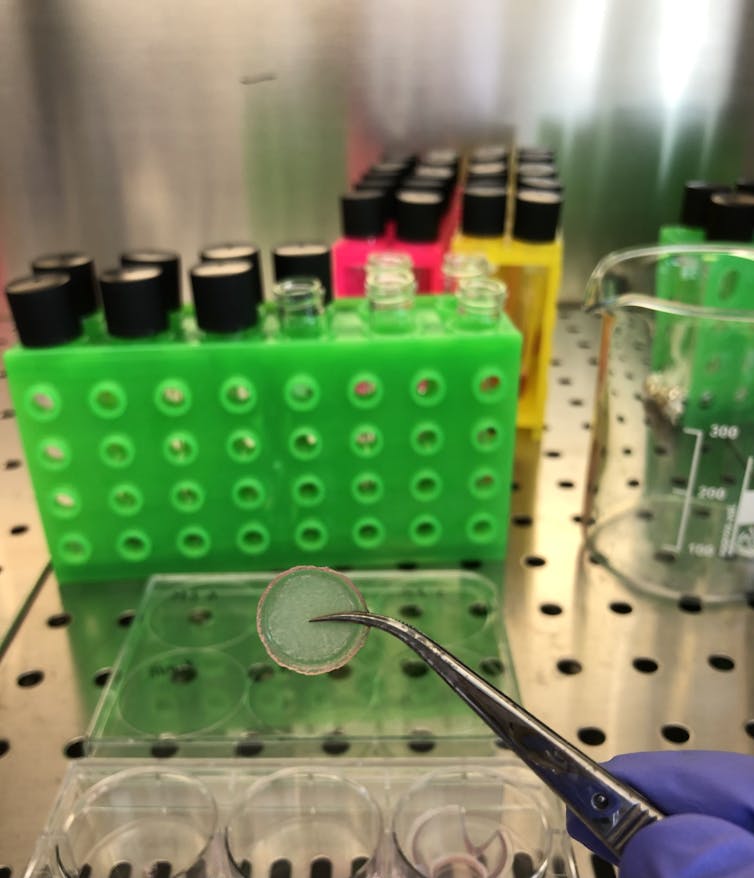
Per- and polyfluoroalkyl substances (PFAS) or synthetic forever chemicals have been detected everywhere from the Arctic ice and its polar bears to penguin colonies in Tasmania, even in rain water and sea spray. These persistent chemicals have been found in the blood of people all over the world, as well as in human breast milk. Indeed, our team has even found them in dust from the International Space Station.
But not much is yet known about how PFAS gets into our bodies. Possible pathways include ingesting (food, water and other products that contain PFAS) or breathing in air contaminated with PFAS particles. Our recent research shows that it’s possible for PFAS to penetrate human skin and reach our bloodstream.
PFAS are found in many consumer products, including skincare products, cosmetics and waterproof clothing. These compounds are often referred to as “forever chemicals” due to their persistence in nature and in the human body where they can stay for many years.
Our new study shows that dermal exposure – absorption of PFAS through the skin – could be an important pathway into the human body. Using 3D models of lab-grown human skin tissue that mimic the properties of real human skin, our team of environmental chemists investigated the dermal permeation (the uptake of a chemical through our skin) of 17 different PFAS chemicals.
Our results suggest, for the first time, that many of these compounds can indeed be absorbed though the human skin, contrary to what has been previously believed about the skin acting as a barrier.

Once in the body, these chemicals can affect our health. Some PFAS disrupt hormone systems and can lower the immune response to childhood vaccinations against diseases such as diptheria. Other concerning effects are lowered birth weight of newborns and changes in liver function. One PFAS (perfluorooctanoic acid or PFOA) was recently designated by the International Agency for Research on Cancer as “carcinogenic to humans”.
Consequently, many studies have focused on quantifying our exposure to PFAS, with most recent research revealing diet and drinking water as important pathways of human exposure to these chemicals.
For our study, we selected 17 PFAS that are already regulated by the EU in drinking water. Our findings shed light on human exposure to these 17 particular chemicals but it’s difficult to extrapolate our results for other PFAS because each compound has different properties and behaviours.
Short v long
Our results showed that long-chain PFAS were not absorbed by the skin as much as short-chain PFAS that contained fewer carbon molecules. So 58% of the applied dose of a PFAS called perfluoropentanoic acid (which contains five carbon molecules) was absorbed by the end of the 36-hour exposure period. However, for the most regulated of the PFAS tested, PFOA (a chemical that contains eight carbons), only 13% of the applied dose had permeated through the skin during the same time period.
We also noticed skin permeation took some time to occur for the PFAS included in the study. However, as these compounds are found in products used every day, such frequent contact could lead to substantial exposure over time.
It had been previously hypothesised that under the conditions found on the surface of our skin, absorption of the PFAS we tested would be minimal. Our study however, shows that this is not the case, as for eight of the tested PFAS, more than 5% of the applied dose was able to fully permeate through the skin into the bloodstream. We also found a substantial fraction of the applied dose within the skin itself that represents a reservoir of PFAS that could later pass through into our bodies.
Our study helps us to understand how important exposure to PFAS via the skin might be and indicate which chemical structures might be most easily absorbed. This is important because we see a shift in industry towards chemicals with shorter chain lengths because they are assumed to be less toxic or less persistent.
But the trade-off might be that we absorb more of these short-chain PFAS as these smaller chemicals are more easily transported through the skin barrier. Manufacturers and regulators need to be sure of the risks involved before bringing PFAS-containing products to market.
Oddný Ragnarsdóttir receives funding from the European Union's Horizon 2020 research and innovation programme under the Marie Skłodowska-Curie grant agreement No 860665 (PERFORCE3 Innovative Training Network).
Mohammed Abdallah receives funding from the European Union's Horizon 2020 research and innovation programme under the Marie Skłodowska-Curie grant agreement No 860665 (PERFORCE3 Innovative Training Network).
Stuart Harrad received funding from the European Union's Horizon 2020 research and innovation programme under the Marie Skłodowska-Curie grant agreement No 860665 (PERFORCE3 Innovative Training Network).
This article was originally published on The Conversation. Read the original article.







